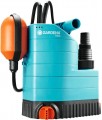Maximum performance
The maximum volume of water that the device can pump in a certain amount of time. It is one of the key specs of any pump because characterizes the volume of water with which the device can work. At the same time, it does not always make sense to pursue maximum performance — after all, it significantly affects the dimensions and weight of the unit.
Some formulas allow you to derive optimal performance values for different situations. So, if the pump is designed to supply water to water intake points, its minimum required performance should not be lower than the highest total flow rate; if desired, a margin of 20-30% can be added to this value. And for sewer models (see "Suitable for"), everything will depend on the volume of wastewater. More detailed recommendations for choosing a pump depending on performance can be found in special sources.
Maximum head
The maximum head generated by the pump. This parameter is most often indicated in meters, by the height of the water column that the unit can create — in other words, by the height to which it can supply water. You can estimate the pressure created by the pump using a simple formula: every 10 m of head corresponds to a pressure of 1 bar.
It is worth choosing a pump according to this parameter, taking into account the height to which it should supply water, as well as adjusting for losses and the need for pressure in the water supply. To do this, it is necessary to determine the difference in height between the water level and the highest point of water intake, add another 10 to 30 m to this figure (depending on the pressure that needs to be obtained in the water supply), and multiply the result by 1.1 — this will be the minimum pressure required.
Max. pressure
The highest pressure that the pump is capable of creating during operation. This parameter is directly related to the maximum head (see above); however, it is less obvious, and therefore, it is indicated rarely.
Maximum immersion depth
The maximum depth at which a submersible pump can be placed without the risk of failure or breakdown. It is usually indicated for fresh water, so in fact it is advisable not to lower the pump to the maximum depth level — after all, the density of the pumped liquid may be greater, which will create off-design loads on the structure.
Suction system
— Single-stage. Suction system with one impeller or similar element. Although such a design loses to a multistage one in terms of efficiency and power, at the same time, its characteristics are quite enough for most tasks; while single-stage pumps are simpler and cheaper. Due to all this, this option is used in most modern units.
— Multistage. This suction system consists of several impellers (or other similar parts that directly provide suction). Such pumps are significantly superior to single-stage ones, they provide powerful pressure and are less sensitive to impurities. At the same time, in fact, all these advantages are needed relatively rarely, and multistage systems are quite expensive. Because of this, they are used in a relatively small number of pumps — they are mainly powerful models designed for situations where one suction stage is not enough.
Suction stages
Number of suction stages.
Single-stage systems assume the presence of one impeller or other similar element on board, multi-stage systems — several. The latter makes it possible to obtain a strong water pressure with an overall compact size.
Outlet size
The thread size for connecting a hose or pipe to the pump outlet. If there is a branch pipe with an external thread in the design, the size is indicated for it; if not, for the internal thread of the inlet.
Anyway, the dimensions of the pump outlet and the mounts on the hose/pipeline connected to it must match — otherwise, you will have to look for adapters. This size is specified in inches and fractions of an inch.
This parameter is relevant primarily for surface models.
Maximum power
Rated power of the pump motor. The more powerful the engine, the higher the performance of the unit, usually, the greater the pressure, suction height, etc. Of course, these parameters largely depend on other features (primarily the pump type, see above); but models similar in design can be compared in terms of power.
Note that high power, usually, increases the size, weight and cost of the pump, and also implies high costs of electricity or fuel (see "Power source"). Therefore, it is worth choosing a pump according to this parameter taking into account the specific situation; more detailed recommendations can be found in special sources.

